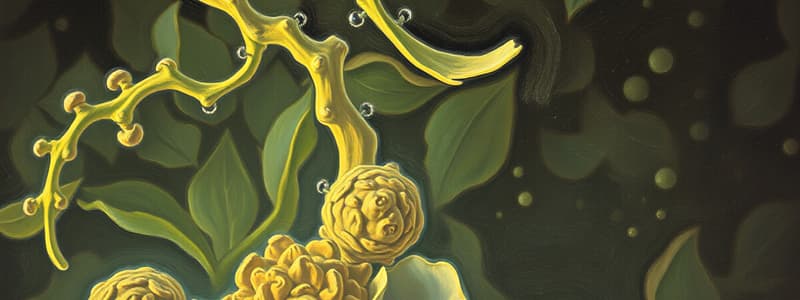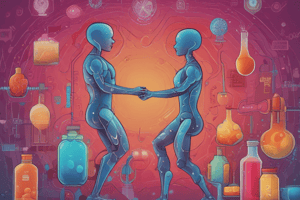Podcast
Questions and Answers
What characterizes anabolism?
What characterizes anabolism?
- It releases energy into the bloodstream.
- It mainly occurs in the digestive system.
- It involves the breakdown of ATP.
- It is characterized by reduction reactions. (correct)
Which stage of catabolic reactions involves the breakdown of large molecules to smaller ones?
Which stage of catabolic reactions involves the breakdown of large molecules to smaller ones?
- Stage 4: Synthesis
- Stage 1: Digestion and hydrolysis (correct)
- Stage 2: Degradation
- Stage 3: Oxidation
What is the main function of catabolic processes in metabolism?
What is the main function of catabolic processes in metabolism?
- To produce ATP from substrates. (correct)
- To synthesize new molecules.
- To store energy for future use.
- To perform work within the cell.
Which of the following correctly describes the relationship between catabolism and anabolism?
Which of the following correctly describes the relationship between catabolism and anabolism?
What is a key feature of multistep enzymatic pathways?
What is a key feature of multistep enzymatic pathways?
What does flux refer to in the context of metabolic pathways?
What does flux refer to in the context of metabolic pathways?
Which system is NOT involved in regulating metabolism?
Which system is NOT involved in regulating metabolism?
In the citric acid cycle, what products are primarily generated?
In the citric acid cycle, what products are primarily generated?
What is the primary role of enterocytes in the intestine?
What is the primary role of enterocytes in the intestine?
What is the purpose of digestion in metabolism?
What is the purpose of digestion in metabolism?
What enhances the surface area of enterocytes for absorption?
What enhances the surface area of enterocytes for absorption?
Which enzyme specifically hydrolyzes sucrose into its monosaccharide components?
Which enzyme specifically hydrolyzes sucrose into its monosaccharide components?
Which of the following substances are absorbed by enterocytes?
Which of the following substances are absorbed by enterocytes?
What role do enterocytes have in hormone secretion?
What role do enterocytes have in hormone secretion?
What is the pH range for the enzyme lactase?
What is the pH range for the enzyme lactase?
What is the outcome of lactase activity on lactose?
What is the outcome of lactase activity on lactose?
Why is transport system considered more important than hydrolysis in monosaccharide absorption?
Why is transport system considered more important than hydrolysis in monosaccharide absorption?
Which is NOT a function of enterocytes?
Which is NOT a function of enterocytes?
Which type of linkage does trehalase hydrolyze in trehalose?
Which type of linkage does trehalase hydrolyze in trehalose?
What is the end product of glycolysis under anaerobic conditions?
What is the end product of glycolysis under anaerobic conditions?
Which of the following cells primarily rely on glycolysis for ATP production?
Which of the following cells primarily rely on glycolysis for ATP production?
What is a prerequisite for the aerobic oxidation of carbohydrates?
What is a prerequisite for the aerobic oxidation of carbohydrates?
Which of the following tissues significantly relies on glycolysis for ATP production due to a low number of mitochondria?
Which of the following tissues significantly relies on glycolysis for ATP production due to a low number of mitochondria?
What critical role does glycolysis play in anoxic episodes?
What critical role does glycolysis play in anoxic episodes?
Which genetic mutation is associated with hemolytic anemia related to glycolysis?
Which genetic mutation is associated with hemolytic anemia related to glycolysis?
What is the initial reaction of pyruvate in the oxidative decarboxylation process?
What is the initial reaction of pyruvate in the oxidative decarboxylation process?
Which condition is most commonly associated with thiamine deficiency?
Which condition is most commonly associated with thiamine deficiency?
What are some common symptoms of thiamine deficiency in chronic alcoholics?
What are some common symptoms of thiamine deficiency in chronic alcoholics?
Why is thiamine deficiency uncommon in the general population?
Why is thiamine deficiency uncommon in the general population?
Which of the following clinical manifestations is NOT typically associated with thiamine deficiency?
Which of the following clinical manifestations is NOT typically associated with thiamine deficiency?
What method of thiamine administration is mentioned for treating deficiency?
What method of thiamine administration is mentioned for treating deficiency?
What is the potential consequence of thiamine deficiency in patients aside from neurological symptoms?
What is the potential consequence of thiamine deficiency in patients aside from neurological symptoms?
In which set of symptoms might a patient experienced due to thiamine deficiency notably include eye problems?
In which set of symptoms might a patient experienced due to thiamine deficiency notably include eye problems?
What is a common misconception about thiamine as a vitamin?
What is a common misconception about thiamine as a vitamin?
What metabolic process is pyruvate primarily involved in under aerobic conditions?
What metabolic process is pyruvate primarily involved in under aerobic conditions?
What is the role of pyruvate decarboxylase in alcoholic fermentation?
What is the role of pyruvate decarboxylase in alcoholic fermentation?
In the Cori's cycle, what happens to lactate produced in the muscles?
In the Cori's cycle, what happens to lactate produced in the muscles?
What does the term 'oxygen debt' refer to in the context of vigorous exercise?
What does the term 'oxygen debt' refer to in the context of vigorous exercise?
Which of the following statements is true about glycolysis?
Which of the following statements is true about glycolysis?
During alcoholic fermentation, what regenerates NAD+ for glycolysis?
During alcoholic fermentation, what regenerates NAD+ for glycolysis?
What is the significance of the Cori's cycle?
What is the significance of the Cori's cycle?
Which enzyme is primarily responsible for converting acetaldehyde to ethanol during alcoholic fermentation?
Which enzyme is primarily responsible for converting acetaldehyde to ethanol during alcoholic fermentation?
What type of conditions does alcoholic fermentation occur under?
What type of conditions does alcoholic fermentation occur under?
What is the first step in glycolysis involving glucose?
What is the first step in glycolysis involving glucose?
How many ATP are consumed during the Embden–Meyerhof–Parnas pathway of glycolysis?
How many ATP are consumed during the Embden–Meyerhof–Parnas pathway of glycolysis?
Flashcards are hidden until you start studying
Study Notes
Metabolism Overview
- Anabolism involves reduction reactions and ATP energy utilization, while catabolism typically releases energy, forming ATP.
- Both processes are interconnected: catabolism generates ATP from food, while anabolism requires ATP for cellular work.
Stages of Metabolism
-
Stage 1: Digestion and Hydrolysis
- Large molecules are broken down into smaller components that enter the bloodstream.
-
Stage 2: Degradation
- Further breakdown and oxidation of these molecules into 2 and 3-carbon compounds.
-
Stage 3: Oxidation
- Small molecules are oxidized to CO2 and H2O in the citric acid cycle, producing ATP.
Metabolic Pathway Regulation
- Metabolism is regulated at four levels: cell membrane, molecular, nervous system, and endocrine system.
- Flux in metabolic pathways depends on substrates, product removal, and enzyme activity.
Digestion of Carbohydrates
- Digestion initiates metabolism by hydrolyzing large carbohydrates into smaller, absorbable units.
- Enterocytes, intestinal absorptive cells, utilize glycoprotein and glycolipid-rich glycocalyx for digestion.
- Microvilli increase the surface area for efficient nutrient transport, secreting hormones like leptin in addition to absorption tasks.
Enzymatic Hydrolysis
- Oligosaccharidases on enterocyte membranes hydrolyze disaccharides to monosaccharides:
- Sucrase: Breaks down sucrose into fructose and glucose.
- Lactase: Hydrolyzes lactose into glucose and galactose.
- Trehalase: Converts trehalose into two glucose molecules.
Pyruvate Dehydrogenase Complex
- Pyruvate undergoes oxidative decarboxylation to produce acetyl-CoA, essential for aerobic metabolism.
Thiamine (Vitamin B1) Importance
- Thiamine is crucial in enzymatic reactions, especially for individuals with alcohol dependence.
- Thiamine deficiency can lead to Wernicke-Korsakoff syndrome and other health issues including progressive cognitive decline, ataxia, and cardiovascular problems.
Alcoholic Fermentation
- Under anaerobic conditions, yeast converts pyruvate to ethanol and CO2, allowing glycolysis to continue by regenerating NAD+.
Cori's Cycle
- Converts glucose to lactate in muscles during exercise; lactate returns to the liver for gluconeogenesis.
- Significantly prevents lactate accumulation in muscles, maintaining energy supply during strenuous activities.
Glycolysis Pathway Significance
- Universal energy production pathway found in all cells, crucial for ATP synthesis.
- Functions under both aerobic and anaerobic conditions; produces pyruvate and lactate respectively.
- Serves as an emergency energy pathway and provides building blocks for amino acids and fats.
- Affected by diseases such as pyruvate kinase deficiency, leading to hemolytic anemia due to reliance on glycolysis in erythrocytes.
Clinical Note
- Impairment of glycolysis can lead to significant medical conditions like hemolytic anemia, highlighting the pathway's importance in energy metabolism.
Studying That Suits You
Use AI to generate personalized quizzes and flashcards to suit your learning preferences.




